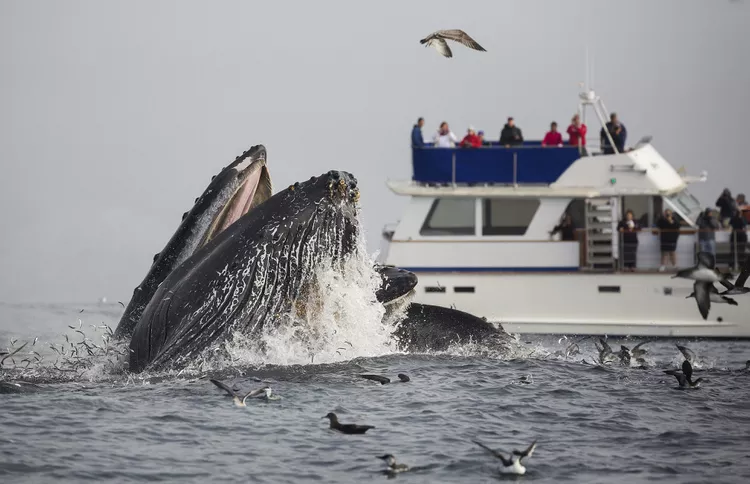Where, When and How to Go Whale Watching on the California Coast
In California, whale watching is a popular activity for tourists, and it’s no surprise. With some of the largest mammals in the world migrating past coastal points, feeding near the shore, and swimming in inlets, there are plenty of ocean creatures to observe.
When to Go Whale Watching in California
Different species have their own migration seasons, but you can find whales off the California coast almost any time of year if you know where to look. Check a reliable whale watching calendar to learn when to see whales and dolphins in California.
For regional advice, you can explore information on cruises, local whale festivals, and great spots to watch the migration from land, including:
- Monterey Whale Watching
- Whale Watching Around San Francisco
- San Diego Whale Watching
- Orange County Whale Watching: Dana Point and Newport Beach
- Los Angeles Whale Watching
- Whale Watching in Northern California
California Whale Watching Cruises
Whale watching cruises range from a two-hour excursion out of a local harbor to multi-day voyages to Baja, Mexico. During winter, you can find them departing from harbors and marinas along the entire California coast.
The quality of whale watching trips can vary significantly. Consider asking these questions to ensure a satisfying experience:
- Is the boat Coast Guard certified?
- Do they use a sighting network?
- Will a naturalist be on board? What is their background?
- How long will the trip last?
- What amenities are provided on the ship? Should you bring your own food?
- Are there enough places to sit comfortably?
- Are they part of a Whale Watching Operators Association?
- Will you receive a complimentary trip if no whales are sighted?
- Beyond technical details, customer experience is crucial. Check ratings for whale watching companies on review sites.
Is a Whale Watching Cruise Worth Your Time?
On the most fortunate days, passengers would undoubtedly say “yes” to this question. However, whale watches may consume precious hours that could be spent exploring other attractions. If you only witness a few sightings (or none), it might not be the best use of your time.
Choosing whether a cruise is worthwhile is subjective, as everyone has different priorities. Recent sighting reports from a couple of companies in your desired area can provide insight. Keep in mind that these reports reflect a full day’s results, which may include multiple trips.
Consider how important the opportunity to see a whale is in comparison to other activities available to you.
Tips for an Enjoyable Whale-Watching Cruise
- Set realistic expectations. Wild animals appear unpredictably. Some days, you may not spot any whales, while on others, you could see multiple.
- Dress in layers. Expect cooler conditions out on the water than what you experience on land. There can be a temperature difference of 20-30°F.
- In winter, consider bringing gloves or mittens. Clean socks can serve as a suitable emergency alternative if you forget.
- Even on clear days, smaller boats can create a considerable spray. Bring a waterproof jacket with a hood.
- Always use sunscreen. Even if you’re shaded, 60% of sunlight reflects off the water’s surface, leading to sunburn—even on cloudy days.
- Departing earlier in the day often leads to smoother rides. Winds typically increase later in the day, generating rough waters.
- If you are prone to motion sickness, carry your preferred remedies. Even if the water seems calm from shore, ocean swells can create a tumultuous ride.
- Wear sunglasses. The glare from the water can lead to headaches.
- Secure hats or visors. Strong winds can easily carry them away.
- Bring entertainment for young children. Be sure they are bundled up, as the cold wind on deck can take away their enthusiasm.
- Leave binoculars at home. Some articles may suggest bringing them, but spotting whales can be challenging on a moving boat.
California Whale Watching From Land
Migrating whales often come closest to portions of the coast that extend the furthest into the ocean. Areas with “Point” in their name or most coastal lighthouses are promising locations for sightings.
Your best approach for spotting whales is to scan the ocean for a spout (a spray of water). Once you see that, keep watching for similar occurrences to determine the direction the whale is heading. Generally, migrating whales travel south in winter and north in spring, moving at about five miles per hour—the speed of a child on a bicycle. Keep binoculars available; as you become skilled at tracking their movements, you’ll get a better view.
Grey whales typically swim in cycles of three to five blows, spaced 30 seconds apart, followed by a dive lasting three to six minutes. They often lift their tail flukes before diving. If they swim just below the surface, they may leave a trail of calm water spots, making them easier to track.
For excellent vantage points to observe whales from the California shore, refer to the regional whale watching guides mentioned earlier.





